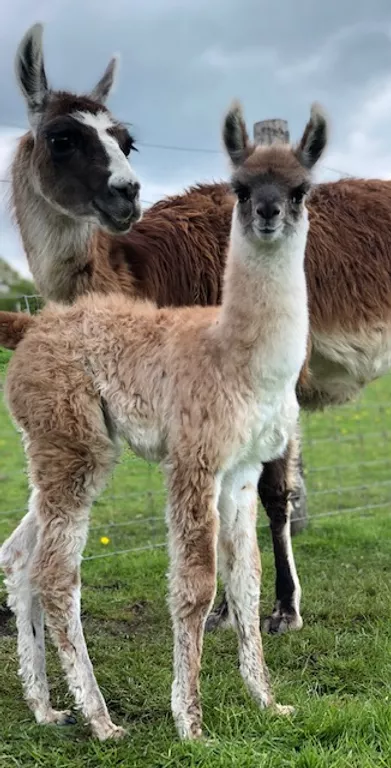To breed or not to breed? That is the question! The first things to consider are whether you have the facilities and what are you going to do with the cria after it has been born. Remember that if you plan to sell it you must be willing to put in the time and effort to make sure it is well handled and halter trained. It is all well and good if you have a suitable male and a suitable female to put together but you must be aware that the male and female must be separated from each other after mating. Failure to do so can result in repeated mating by the male – leading to the possibility of intrauterine infections, loss of the pregnancy and it has known to result in the death of the female. After the birth the female should not go back to the male for between 19 and 27 days. Whether the cria is a female or male it will have to be kept away from the stud male from about six months or else the stud may try to cover its daughter or fight with its son. When they have been separated you will need a same-sex companion for the weanling and a separate paddock for them.
Next, you must consider whether the male and female are suitable for breeding.
Do they have proper genitalia?
Do they have any major conformation faults?
When deciding which males and females to breed be objective and not emotional. Very few llamas are without some faults so when choosing a mate for your female select a male that will improve her less-than-perfect qualities.
Llamas are induced ovulators, which means that a female does not ovulate until she has been stimulated by the male and so females can conceive at any time.
The average llama is pregnant for 340 to 345 days but gestation can actually range from 300 to 375 days. Because of the female being an induced ovulator you can chose the time of year that your cria is born, however The British Llama Society recommends that breeders plan for late Spring / early Summer births, which is when conditions are optimal for the survival of cria.
There are several methods of breeding and which you use depends on your time and facilities. The most natural breeding method is pasture breeding where the male remains in his field and the females are introduced to him there and removed again, immediately after mating. This is minimal stress and ensures that the male will keep breeding with a female as long as she is open. The disadvantage is that this can cause internal damage to the female and can also introduce interuterine infection. To prevent this, the female must be removed from the field and then re-introduced around a week later. The other problem is that since you cannot watch them all the time you don’t know when the female has been successfully covered.
The second method is hand breeding and requires that both the male and female and are halter trained and are kept separately. The female is introduced to the male in a catch pen/stable. After the initial breeding the two are separated and then re-introduced seven days later. If the female lets the male cover her she has not yet ovulated. Continue to re-introduce them until the female refuses the male. This method gives you a better idea of when the cria might be due.
Whichever method you use you can test if the female has conceived either by blood testing for progesterone levels after 21 days of her refusing the male or by an ultra sound scan after 50 days.
The male and female llamas must not be kept together after mating and they must definitely be out of sight and smell of each other before the female gives birth. Males will be attracted by the female’s changing hormone levels before birth and it is common for them to challenge fencing in order to get to the female. It has been known for the male to try to cover the female while she is giving birth, with some very bad results.
Most births happen during the day. Some llamas show signs of getting near giving birth but others do not, particularly first-time mothers. In most llamas the mammary glands fill with milk between one to six weeks before the birth. When the birth is nearly due the rear end of the female becomes slack and the vulva elongates.
The mother-to-be often appears restless, stands alone humming, goes to the dung pile often and lies down and gets up frequently. Normally the cria’s front legs appear first followed by the nose and the mother generally remains standing. The drop to the ground breaks the umbilical cord and almost immediately the baby will begin rolling and trying to sit up. It is usually on its feet and suckling within a few hours. When the baby is born you can dry it with a towel and then you must spray the umbilical with iodine. The last stage of the birthing process is the expulsion of the placenta (after- birth) within four to six hours. If it hasn’t been passed after twelve hours do not try to pull it out. Seek veterinary help. The after-birth should be examined for infection, tears, haemorrhaging and completeness. You want to make sure the cria is standing, nursing and passing droppings. Take time to enjoy the miracle of a new llama!


